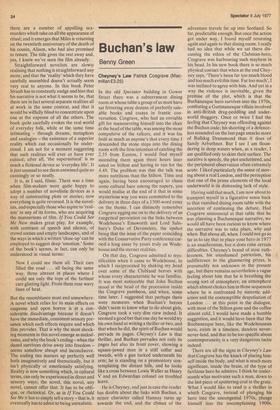Buchan's law
Benny Green
Cheyney's Law Patrick Cosgrave (Macmillan £3.25) In the old Spectator building in Gower Street there was a subterranean dining room at whose table a group of us must have sat frittering away dozens of perfectly saleable books and essays in frantic conversation. Cosgrave, who had an enviable gift for manouevring himself into the chair at the head of the table, was among the most' compulsive of the talkers, and it was his fault as much as anyone's that every time I descended the stone steps into the dining room with the firm intention of catching the 2.35 from Euston, I would find myself ascending them again three hours later sated on Stilton and having to run for the 4.48. The problem was that the talk was more nutritious than the Stilton. Time and again, having been encouraged to chase some cultural hare among the napery, you would realise at the end of it that in some mysterious way you were committed to the delivery in three days of a 1500-word essay on the theme. I can distinctly remember Cosgrave egging me on to the delivery of an exegetical peroration on the links between Wodehouse's Emsworth and Lord Salisbury's Duke of Devonshire, the upshot being that the issue of the paper coinciding with the Conservative Party conference carried a long essay by yours truly on Wodehouse and the sterner realities.
On that day, Cosgrave admitted to mystification when it came to Wodehouse, to which I reciprocated by shaking my ,head over some of the Clubland heroes with whose every characteristic he was familiar. It was most noticeable that John Buchan stood at the head of the procession inside the Cosgrave pantheon, and when, some time later, I suggested that perhaps there were moments when Buchan's heroes didn't seem to know what to do about girls, Cosgrave took a very dim view indeed. It seemed a good bet that one day he would try his own hand at writing a thriller or two, and that when he did, the spirit of Buchan would pervade its pages. Cheyney's Law is that thriller, and Buchan pervades not only its pages but also its front cover, showing a square-jawed man in a stiff collar and tweeds, with a gun tucked underneath his arm; he is standing on a promontory con• templating the distant hills, and he looks like a cross between Lewis Waller as Henry V and an Edwardian colonel on troubled leave.
He is Cheyney, and just in case the reader has doubts about the links with Buchan, a minor character called Hannay turns up towards the end, and the climax of the adventure travels far up into Scotland. So far, predictable enough. But once the action got under way, I found myself returning again and again to that dining room. I really had no idea that while we sat there discussing the ethics of the Clubman-hero, Cosgrave was harbouring such mayhem in his head. In his new book there is so much physical contact that when at the end Cheyney says, 'There's been far too much blood and too much evil this time. Far too much', I was inclined to agree with him. And yet in a way the violence is inevitable, given the premise of the plot, which is that the Buchanesque hero survives into the 1970s, combating a Guttmanesque villain involved in anti-British drug-peddling and underworld thuggery. Once or twice I had the feeling that Cheyney was offending against the Buchan code; his shooting of a defenceless scoundrel on the last page smacks more of Bulldog Drummond than it does of Sandy Arbuthnot. But I see I am floundering in deep waters when, as a reader, I am qualified only to skim their surface. The narative is speedy, the plot uncluttered, and the peripheral observation often extremely acute, I liked particularly the sense of moving about a real London, and the perception that one of the prime elements of the local underworld is its distressing lack of style.
Having said that much, I am now about to transport myself in a figurative sense back to that vanished dining room table with the intention of continuing the debate. Had Cosgrave announced at that table that he was planning a Buchanesque narrative, we would all have been curious to know where the narrative was to take place, why and when. But above all, when. I could not go go far as to say that to place your hero in 1977 is an anachronism, but it does raise certain difficulties. Cheyney's brand of stoic ruthlessness, his unashamed patriotism, his indifference to the glimmering prizes, is presumably not unknown in the present age, but there remains nevertheless a vague feeling about him that he is breathing the wrong sort of atmosphere, an atmosphere which almost chokes him in those sequences where he is confronted by narcotic addiction and the contemptible despoliation of London at this point in the dialogue, with most of the Stilton gone and the coffee almost cold, I would have made a humble suggestion, and it would have been that the Buchanesque hero, like the Wodehousean hero, exists in a timeless, dateless nevernever-land, and that to be too specific about contemporaneity is a very dangerous tactic indeed.
There are all the signs in Cheyney's Law that Cosgrave has the knack of placing himself inside the body, and what is much more significant, inside the brain, of the type of fictitious hero he admires. I think he understands what motivates such a man, down to the last piece of sputtering coal in the grate. What I would like to read is a thriller in which Cosgrave, instead of plunging his hero into the uncongenial 1970s, plunge himself into the uncomplaining 1900s.


































 Previous page
Previous page